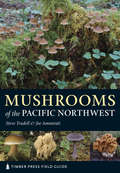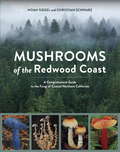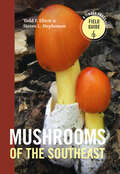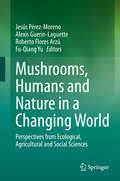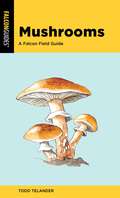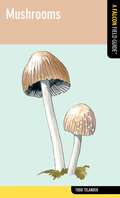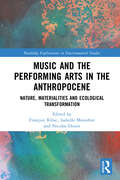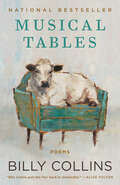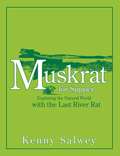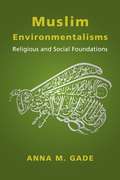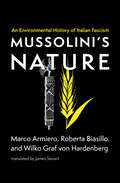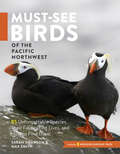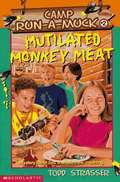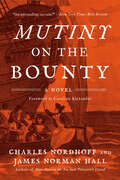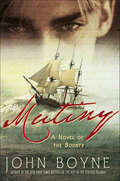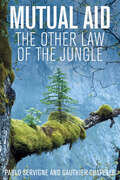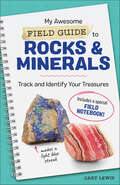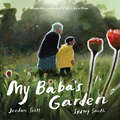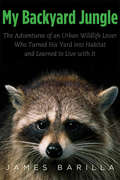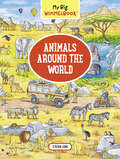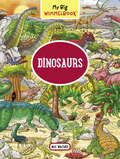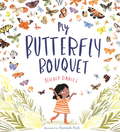- Table View
- List View
Mushrooms of the Pacific Northwest, Revised Edition (A Timber Press Field Guide)
by Steve TrudellIdeal for hikers, foragers, and naturalists, the Timber Press Field Guides are the perfect tools for loving where you live.Mushrooms of the Pacific Northwest is a comprehensive field guide to the most conspicuous, distinctive, and ecologically important mushrooms found in the region. With helpful identification keys and photographs and a clear, color-coded layout, Mushrooms of the Pacific Northwest is ideal for hikers, foragers, and natural history buffs and is the perfect tool for loving where you live. Covers Oregon, Washington, and British Columbia Describes and illustrates 493 species 530 photographs, with additional keys and diagrams Clear color-coded layout
Mushrooms of the Pacific Northwest: Timber Press Field Guide (A Timber Press Field Guide)
by Joe Ammirati Steve TrudellExplore the heart of mushroom country The Pacific Northwest is one of the best places to find mushrooms—they are both abundant and spectacularly diverse. Yet until now, there has been no mushroom guide that focuses on the region. This compact, beautifully illustrated guide presents descriptions and photographs of 460 of the region's mushrooms. In addition to profiles on individual species, Mushrooms of the Pacific Northwest also includes a general discussion and definition of fungi, information on where to find mushrooms and guidelines on collecting them, an overview of fungus ecology, and a discussion on how to avoid mushroom poisoning.
Mushrooms of the Redwood Coast: A Comprehensive Guide to the Fungi of Coastal Northern California
by Christian Schwarz Noah SiegelA comprehensive and user-friendly field guide for identifying the many mushrooms of the northern California coast, from Monterey County to the Oregon border. Mushrooms of the Redwood Coast will help beginning and experienced mushroom hunters alike to find and identify mushrooms, from common to rare, delicious to deadly, and interesting to beautiful. This user-friendly reference covers coastal California from Monterey County to the Oregon border with full treatments of more than 750 species, and references to hundreds more. With tips on mushroom collecting, descriptions of specific habitats and biozones, updated taxonomy, and outstanding photography, this guide is far and away the most modern and comprehensive treatment of mushrooms in the region. Each species profile pairs a photograph with an in-depth description, as well as notes on ecology, edibility, toxicity, and look-alike species. Written by mushroom identification experts and supported by extensive field work, Mushrooms of the Redwood Coast is an indispensable guide for anyone curious about fungi.From the Trade Paperback edition.
Mushrooms of the Southeast: Timber Press Field Guide (A Timber Press Field Guide)
by Steven L. Stephenson Todd F. ElliottMushrooms of the Southeast is a compact, beautifully illustrated guide packed with descriptions and photographs of more than 400 of the region’s most important mushrooms. The geographic range covered by the book includes northern Florida, Georgia, South Carolina, North Carolina, Virginia, Delaware, Maryland, West Virginia, Kentucky, Tennessee, Arkansas, Louisiana, Mississippi, and Alabama. In addition to profiles on individual species, the book also includes a general discussion and definition of fungi, information on where to find mushrooms and collection guidelines, an overview of fungus ecology, and information on mushroom poisoning and how to avoid it.
Mushrooms, Humans and Nature in a Changing World: Perspectives from Ecological, Agricultural and Social Sciences
by Jesús Pérez-Moreno Alexis Guerin-Laguette Roberto Flores Arzú Fu-Qiang YuThis book focuses on recent advances in our understanding of wild edible mycorrhizal fungi, truffle and mushrooms and their cultivation. In addition to providing fresh insights into various topics, e.g. taxonomy, ecology, cultivation and environmental impact, it also demonstrates the clear but fragile link between wild edible mushrooms and human societies. Comprising 17 chapters written by 41 experts from 13 countries on four continents, it enables readers to grasp the importance of protecting this unique, invaluable, renewable resource in the context of climate change and unprecedented biodiversity loss. The book inspires professionals and encourages young researchers to enter this field to develop the sustainable use of wild edible mushrooms using modern tools and approaches. It also highlights the importance of protecting forested environments, saving species from extinction and generating a significant income for local populations, while keeping alive and renewing the link between humans and wild edible mushrooms so that in the future, the sustainable farming and use of edible mycorrhizal mushrooms will play a predominant role in the management and preservation of forested lands.
Mushrooms: A Falcon Field Guide
by Todd TelanderMushrooms: A Falcon Field Guide covers 80 of the most common and sought-after species in North America. Conveniently sized to fit in a pocket and featuring full-color, detailed illustrations, this informative guide makes it easy to identify mushrooms in the backyard and beyond. Each mushroom is accompanied by a detailed listing of its prominent attributes and a color illustration showing its important features. Mushrooms are organized in phylogentic order, keeping families of mushrooms together for easy identification. This is the essential source in the field, both informative and beautiful to peruse.
Mushrooms: A Falcon Field Guide (Falcon Field Guide Series)
by Todd TelanderMushrooms: A Falcon Field Guide covers 80 of the most common and sought-after species in North America. Conveniently sized to fit in a pocket and featuring full-color, detailed illustrations, this informative guide makes it easy to identify mushrooms in the backyard and beyond. Each mushroom is accompanied by a detailed listing of its prominent attributes and a color illustration showing its important features. Mushrooms are organized in phylogentic order, keeping families of mushrooms together for easy identification. This is the essential source in the field, both informative and beautiful to peruse.
Music and the Performing Arts in the Anthropocene: Nature, Materialities and Ecological Transformation (Routledge Explorations in Environmental Studies)
by François Ribac Isabelle Moindrot Nicolas DoninMusic and the Performing Arts in the Anthropocene offers a series of thought-provoking chapters about music and the performing arts viewed from current Anthropocene-aware perspectives. From the use of gas, water and air in 19th-century stage practices to the ecology of musical instruments and sound reproduction technologies, waste and carbon print in experimental music and theatrical production, knowledge of precariousness and empowerment through music in a changing world, each chapter aims at highlighting an issue that has always been here but never looked at thoroughly, due to the divides and hierarchies of the modern cosmogony.Gathering 16 scholars from a variety of disciplinary backgrounds (history of literature, opera and theatre studies, musicology, sound studies, sociology, information science, etc.), this volume reflects on the relationships between the performing arts, music and environmental issues. It also explores a number of tools for changes and sketches how we will understand the arts, their history and their future beyond ecocriticism.This book will be of great interest to students and scholars in the humanities and social sciences, as well as a broader readership involved in art and environment policies.
Musical Tables: Poems
by Billy CollinsNATIONAL BESTSELLER • From the former United States Poet Laureate and New York Times bestselling author of Aimless Love, a collection of more than 125 small poems, all of them new, and each a thought or observation compressed to its emotional essence&“Whenever I pick up a new book of poems, I flip through the pages looking for small ones. Just as I might have trust in an abstract painter more if I knew he or she could draw a credible chicken, I have faith in poets who can go short.&”—Billy CollinsYou can spot a Billy Collins poem immediately. The amiable voice, the light touch, the sudden turn at the end. He "puts the &‘fun&’ back in profundity,&” says poet Alice Fulton. In his own words, his poems tend to &“begin in Kansas and end in Oz.&”Now &“America&’s favorite poet&” (The Wall Street Journal) has found a new form for his unique poetic style: the small poem. Here Collins writes about his trademark themes of nature, animals, poetry, mortality, absurdity, and love—all in a handful of lines. Neither haiku nor limerick, the small poem pushes to an extreme poetry&’s famed power to condense emotional and conceptual meaning. Inspired by the small poetry of writers as diverse as William Carlos Williams, W.S. Merwin, Kay Ryan, and Charles Simic, and written with Collins&’s recognizable wit and wisdom, the poems of Musical Tables show one of our greatest poets channeling his unique voice into a new phase of his exceptional career.3:00 AMOnly my handis asleep,but it&’s a start.
Muskrat for Supper
by Kenny SalweyMuskrat for Supper inspires young people to explore nature's life cycles and understand the concept of the circle of life, as told through the tale of a family that embarks on a hunting and trapping adventure. It is an endearing story that weaves together such themes as sustainable living, our natural environment, and living closer to nature. The first book for children by this acclaimed storyteller and author, Muskrat for Supper includes questions young people have asked Kenny Salwey about his lifestyle as a river rat living off the land. The story will be illustrated with black-and-white photographs as well as nonfiction material to supplement the text. Kenny Salwey is the last of a breed of men whose lifestyle has all but disappeared in this fast-paced, high-tech digital world. For thirty years, this weathered woodsman eked out a living on the Mississippi River running a trapline, hiring out as a river guide, digging and selling roots and herbs, and eating the food he hunted and fished. Today Salwey is a master storyteller, environmental educator, keynote speaker, nature writer, and advocate for the Upper Mississippi River. He has presented his true-life adventures and words of natural world wisdom to both adult and young audiences across the upper Midwest. By sharing his hard-learned experiences, his respect for the Mississippi River, and his love of the natural world, Salwey hopes to inspire his audiences to protect this precious and fragile ecosystem.
Muslim Environmentalisms: Religious and Social Foundations
by Anna M. GadeHow might understandings of environmentalism and the environmental humanities shift by incorporating Islamic perspectives? In this book, Anna M. Gade explores the religious and cultural foundations of Islamic environmentalisms. She blends textual and ethnographic study to offer a comprehensive and interdisciplinary account of the legal, ethical, social, and empirical principles underlying Muslim commitments to the earth.Muslim Environmentalisms shows how diverse Muslim communities and schools of thought have addressed ecological questions for the sake of this world and the world to come. Gade draws on a rich spectrum of materials―scripture, jurisprudence, science, art, and social and political engagement―as well as fieldwork in Indonesia and Southeast Asia. The book brings together case studies in disaster management, educational programs, international development, conservation projects, religious ritual and performance, and Islamic law to rethink key theories. Gade shows that the Islamic tradition leads us to see the environment as an ethical idea, moving beyond the established frameworks of both nature and crisis. Muslim Environmentalisms models novel approaches to the study of religion and environment from a humanistic perspective, reinterpreting issues at the intersection of numerous academic disciplines to propose a postcolonial and global understanding of environment in terms of consequential relations.
Mussolini's Nature: An Environmental History of Italian Fascism
by Marco Armiero Roberta Biasillo Wilko Graf von HardenbergThis exploration of the environmental practices of Benito Mussolini&’s fascist regime invites readers to consider the ecological connections of all political projects.&“We might think we see a mountain while it was a war; a forest can actually be an engine; a monument to workers might reflect the violence of a colonial empire.&”—extracted from Mussolini&’s Nature In this first environmental history of Italian fascism, Marco Armiero, Roberta Biasillo, and Wilko Graf von Hardenberg reveal that nature and fascist rhetoric are inextricable. Mussolini&’s Nature explores fascist political ecologies, or rather the practices and narratives through which the regime constructed imaginary and material ecologies functional to its political project. The book does not pursue the ghost of a green Mussolini by counting how many national parks were created during the regime or how many trees planted. Instead, the reader is trained to recognize fascist political ecology in Mussolini&’s speeches, reclaimed landscapes, policies of economic self-sufficiency, propaganda documentaries, reforested areas, and in the environmental transformation of its colonial holdings. The authors conclude with an examination of the role of fascist landscapes in the country&’s postwar reconstruction: Mussolini&’s nature is still visible today through plaques, monuments, toponomy, and the shapes of landscapes. This original, and surprisingly intimate, environmental history is not merely a chronicle of conservation in fascist Italy but also an invitation to consider the socioecological connections of all political projects.
Must-See Birds of the Pacific Northwest: 85 Unforgettable Species, Their Fascinating Lives, and How to Find Them
by Sarah Swanson Max SmithMust-See Birds of the Pacific Northwest is a lively, practical guide that helps readers discover 85 of the region’s most extraordinary birds. Each bird profile includes notes on what they eat, where they migrate from, and where to find them in Washington and Oregon. Profiles also include stunning color photographs of each bird. Birds are grouped by what they are known for or where they are most likely to be found—like beach birds, urban birds, colorful birds, and killer birds. This is an accessible guide for casual birders, weekend warriors, and families looking for an outdoor experience. Eight easy-going birding weekends, including stops in Puget Sound, the Central Washington wine country, and the Klamath Basin, offer wonderful getaway ideas and make this a must-have guide for locals and visitors alike.
Mutilated Monkey Meat (Camp Run-A-Muck #2)
by Todd StrasserWhen someone who calls himself "The Candyman" begins to sell candy to hungry fellow campers at outrageous prices, assistant cooks Lucas and Justin decide to get even by concocting an out-of-the-ordinary shish kebob.
Mutiny on the Bounty
by Charles Nordhoff James Norman HallThis "astounding sea tale" (New York Times) inspired by real events will thrill readers young and old with its action-packed account of treachery and survival in the South Pacific. Cherished as one of the most thrilling sea adventures ever recorded, Mutiny on the Bounty has sold millions of copies and enthralled generations of readers around the world in the eight decades since its initial publication. The novel reprises a true story -- the strange, eventful, and tragic voyage of His Majesty's Ship Bounty in 1788-1789, which culminated in Fletcher Christian's mutiny against Captain Bligh -- and reaches peaks of narrative excitement that mark the book indelibly as a modern classic. The story of the Bounty continues in Men Against the Sea and Pitcairn's Island. "A superb achievement...Here is what the historical novel should be -- a bit of history brought to life in a book." --New York Times
Mutiny: A Novel of the Bounty
by John Boyne“Enthralling . . . Boyne’s novel can stand comparison with William Golding’s Rites of Passage . . . Mutiny is storytelling at its most accomplished.” —The Independent (UK)Internationally bestselling author John Boyne has been praised as “one of the best and original of the new generation of Irish writers” by the Irish Examiner. With Mutiny, he’s created an eye-opening story of life—and death—at sea.Fourteen-year-old pickpocket John Jacob Turnstile has just been caught red-handed and is on his way to prison when an offer is put to him—a ship has been refitted over the last few months and is about to set sail with an important mission. The boy who was expected to serve as the captain’s personal valet has been injured and a replacement must be found immediately.Given the choice of prison or a life at sea, John soon finds himself on board, meeting the captain, just as the ship sets sail. The ship is the Bounty, the captain is William Bligh, and their destination is Tahiti. Their journey, however, will become one of the most infamous in naval history.Mutiny is the first novel to explore all the events relating to the Bounty’s voyage, from the long passage across the ocean to their adventures on the island of Tahiti and the subsequent forty-eight-day expedition toward Timor. This vivid retelling of the notorious mutiny is packed with humor, violence, and historical detail, while presenting an intriguingly different portrait of Captain Bligh and Mr. Christian than has ever been presented before.“The writing grows into a mesmerizing tour-de-force . . . this is a remarkable and compelling piece of storytelling.” —The Irish Times
Mutual Aid: The Other Law of the Jungle
by Pablo Servigne Gauthier ChapelleIn the merciless arena of life, we are all subject to the law of the jungle, to ruthless competition and the survival of the fittest – such is the myth that has given rise to a society that has become toxic for our planet and for our and future generations. But today the lines are shifting. A growing number of new movements and thinkers are challenging this skewed view of the world and reviving words such as ‘altruism’, ‘cooperation’, ‘kindness’ and ‘solidarity’. A close look at the wide spectrum of living beings reveals that, at all times and in all places, animals, plants, microorganisms and human beings have practised different forms of mutual aid. And those which survive difficult conditions best are not necessarily the strongest, but those which help each other the most. Pablo Servigne and Gauthier Chapelle explore a vast, forgotten continent of mutual aid in order to discover the mechanisms of this ‘other law of the jungle’. In so doing, they provide a more rounded view of the world of living things and give us some of the conceptual tools we need to move beyond the vicious circle of competition and self-destruction that is leading our civilization to the verge of collapse.
My Awesome Field Guide to Rocks & Minerals: Track and Identify Your Treasures (My Awesome Field Guide for Kids)
by Gary LewisBecome a rock hound with this field guide for kids ages 7 to 10The world of rocks and minerals is massive, amazing, and full of cool new things to uncover! My Awesome Field Guide to Rocks and Minerals teaches you the skills you need to collect, identify, and catalog your own treasures.Explore 150 different rocks and minerals, and get step-by-step guidelines for testing and identifying the ones you encounter out in the field. There's also plenty of notebook space so you can record data about your finds. So get out there, gather cool looking samples, and discover what they are!My Awesome Field Guide to Rocks and Minerals includes:An intro to earth science—Explore the layers of the earth, how rocks and minerals are formed, the periodic table, and more essential information for young scientists.Handy fact sheets—Learn more about all kinds of unique rocks and minerals with fact sheets that are conveniently organized to help with identification.A field notebook—Record all your rock-hunting sample data on pages that include cut-out numbers for cataloging.Identify and catalog rocks and minerals with this fascinating field guide that has everything you need to get started.
My Baba's Garden
by Jordan ScottThe special relationship between a child and his grandmother is depicted in this sumptuous book by an award-winning team.Inspired by memories of his childhood, Jordan Scott's My Baba&’s Garden explores the sights, sounds, and smells experienced by a child spending time with their beloved grandmother (Baba), with special attention to the time they spent helping her tend her garden, searching for worms to keep it healthy. He visits her every day and finds her hidden in the steam of boiling potatoes, a hand holding a beet, a leg opening a cupboard, an elbow closing the fridge, humming like a night full of bugs when she cooks.Poet Jordan Scott and illustrator Sydney Smith&’s previous collaboration, I Talk Like a River, which received a Boston Globe-Horn Book Award expored a cherished memory shared between a father and son. In their new book, they turn that same wistful appreciation to the bond between a boy and his grandmother. Sydney Smith&’s illustrations capture the sensational impressions of a child&’s memory with iconic effect.A Junior Library Guild Gold Standard Selection
My Backyard Jungle: The Adventures of an Urban Wildlife Lover Who Turned His Yard into Habitat and Learned to Live with It
by James BarillaFor James Barilla and his family, the dream of transforming their Columbia, South Carolina, backyard into a haven for wildlife evoked images of kids catching grasshoppers by day and fireflies at night, of digging up potatoes and picking strawberries. When they signed up with the National Wildlife Federation to certify their yard as a wildlife habitat, it felt like pushing back, in however small a way, against the tide of bad news about vanishing species, changing climate, dying coral reefs. Then the animals started to arrive, and Barilla soon discovered the complexities (and possible mayhem) of merging human with animal habitats. What are the limits of coexistence, he wondered? To find out, Barilla set out across continents to explore cities where populations of bears, monkeys, marmosets, and honeybees live alongside human residents. My Backyard Jungle brings these unique stories together, making Barillaâ TMs yard the centerpiece of a meditation on possibilities for coexistence with animals in an increasingly urban world. Not since Gerald Durrell penned My Family and Other Animals have readers encountered a naturalist with such a gift for storytelling and such an open heart toward all things wild.
My Big Wimmelbook® - Animals Around the World: A Look-and-find Book (kids Tell The Story) (My Big Wimmelbooks #0)
by Stefan LohrMy Big Wimmelbooks let kids ages 2 to 5 be the storytellers with hours of seek-and-find hands-on learning—and fun! This one-of-a-kind picture book features six panoramic scenes that are bursting with life—and tons to discover! First, your child will meet a colorful cast of characters: a pair of wildlife photographers, a daredevil adventurer, and more. Then, as they explore the scenes—from the Antarctic region to the African plains—children as young as two will have a blast pointing out recognizable things, while older kids will begin to find the star characters . . . and tell their stories! It’s hours upon hours of fun—and an effortless introduction to literacy to boot. About Wimmelbooks Wimmelbooks originated in Germany decades ago and have become a worldwide sensation with children (and adults!) everywhere. My Big Wimmelbooks is the first-ever Wimmelbook series to feature Wimmelbooks as Wimmelbooks in English. They’ve been praised as “lively . . . and abounding with humor and detail” (WSJ), likely to “make any parent’s heart sing.” (NYT)
My Big Wimmelbook® - Dinosaurs: A Look-and-find Book (kids Tell The Story) (My Big Wimmelbooks #0)
by Max WaltherMy Big Wimmelbooks let kids ages 2 to 5 be the storytellers with hours of seek-and-find hands-on learning—and fun! In these one-of-a-kind picture books, every page is bursting with life—and tons to discover! Children as young as age 2 have a blast pointing out recognizable things, while older kids can follow the star characters from page to page, telling their stories along the way. How? Wimmelbooks are virtually instruction-free, inviting kids to make their own way through the busy Wimmelworld they encounter, and to craft their own stories. First, you’re introduced to a unique cast of characters who are hidden in plain sight on the pages that follow. As you seek them out, each character’s storyline unfolds, but it’s up to kids to interpret the scenes and create stories they think fit. It’s hours upon hours of fun—and an effortless introduction to literacy to boot. My Big Wimmelbook—Dinosaurs is a blast from the past—the Mesozoic Era, to be exact! From the famous Tyrannosaurus to the curious Triceratops, readers will be introduced to a cast of unique dino-kids as they go about their day swimming, flying, and stampeding through the dense jungle, by the seaside, up a bustling river, and more! About Wimmelbooks About Wimmelbooks Wimmelbooks originated in Germany decades ago and have become a worldwide sensation with children (and adults!) everywhere. My Big Wimmelbooks is the first-ever Wimmelbook series to feature Wimmelbooks as Wimmelbooks in English. They’ve been praised as “lively . . . and abounding with humor and detail” (WSJ), likely to “make any parent’s heart sing.” (NYT)
My Big Wimmelbook® - Tractors Everywhere (My Big Wimmelbooks #0)
by Max WaltherThese tractors and the busy workers who drive them are helping out on the farm, doing new jobs for each season! The My Big Wimmelbooks® series is an effortless introduction to literacy that lets beginning readers ages 2 to 5 be the storyteller—with hours of seek-and-find hands-on learning. In these oversize board books, every page is bursting with life—and tons to discover! Children as young as age 2 have a blast pointing out recognizable things—a blue tricycle, a hungry dog, a piggyback ride—while older kids can follow the star characters through all kinds of bustling scenes. Wimmelbooks are virtually instruction-free, inviting kids to make their own way through the busy Wimmelworld they encounter—and to craft their own stories. First, they’re introduced to a unique cast of characters who are hidden in plain sight on the pages that follow. As children seek them out, each character’s storyline unfolds, but it's up to kids to interpret the scenes and create stories they think fit. It’s hours upon hours of fun—and an effortless introduction to literacy, to boot. My Big Wimmelbook®—Tractors Everywhere brings kids to a bustling farm where tractors are chugging away: churning up the fields, shoveling scrap, mowing grass, and hauling bushels of apples and potatoes. Children can follow a cast of hard workers and their machines through rural life in the spring, summer, fall, and winter, discovering how the seasons change what’s going on in nature and which jobs the tractors do. There’s also a spread of diagrams with simple labels so curious kids can learn to point out parts like the tires, cab, and engine. About Wimmelbooks Wimmelbooks originated in Germany decades ago and have become a worldwide sensation with children (and adults!) everywhere. My Big Wimmelbooks® is the first-ever English-language wimmelbook series. Its books have been praised as “lively . . . and abounding with humor and detail” (WSJ) and likely to “make any parent’s heart sing” (NYT).
My Book of Rocks and Minerals: Things to Find, Collect, and Treasure (My Book of)
by Devin DennieA stunning visual reference book for little geologists who love to find fascinating rocks all around them. Identify colorful gemstones, sparkly crystals, the toughest rocks, and ancient fossils. Packed with fun facts, information, and extensive photos all about the rocks and minerals that make up the world around us.Interactive learning that engages young scholarly minds. Learn about 64 different types of rocks and minerals, how to tell the difference between them and where to find them. Dig into all the interesting geological materials from deep space to the deepest caves. You&’ll even discover glow in the dark minerals and living gems!Find out about the stuff our world is made of, and how rocks and minerals form over time. This captivating book introduces children to hands-on science with fun activities like starting your own impressive rock collection and how to stay safe on your rock finding missions.Written for kids aged 6 to 9 with bite-sized information and explanations. The easy-to-understand language gives them a rock-solid foundation for science subjects. The geology book includes the phonetic pronunciation of the rock and mineral names so your little one will sound like a rock expert in no time.Rockin&’ It With Stones And Minerals • Stunning high-quality photographs. • Inspiring activities for little Earth scientists. • Over 64 types of rocks, their properties, and how they are formed.
My Butterfly Bouquet
by Nicola DaviesWith breathtaking illustrations and a touching story, this dazzling picture book introduces young readers to one of nature's most magnificent and essential insects: the butterfly.See how a little girl recovering from poor health finds wonder in nature and delights in planting a garden with her father to attract a fascinating array of butterflies. Exploring the life stages of butterflies, their importance to our ecosystems and the revitalising power of nature, this book is a heart-warming information story for children who love the outdoors and all its incredible creatures.At the back of the book, discover tips on how to create your own wildlife garden to attract betterflies!

